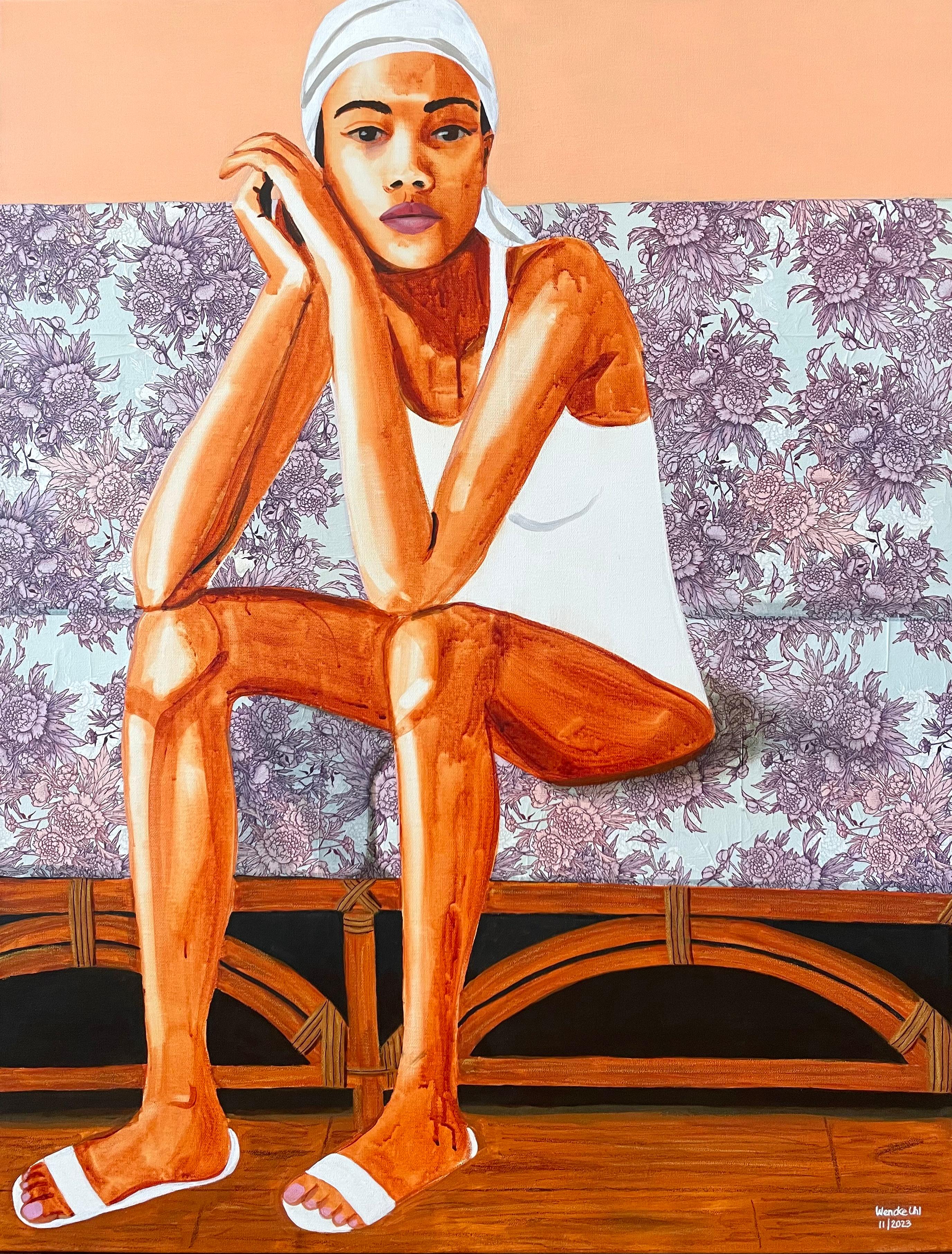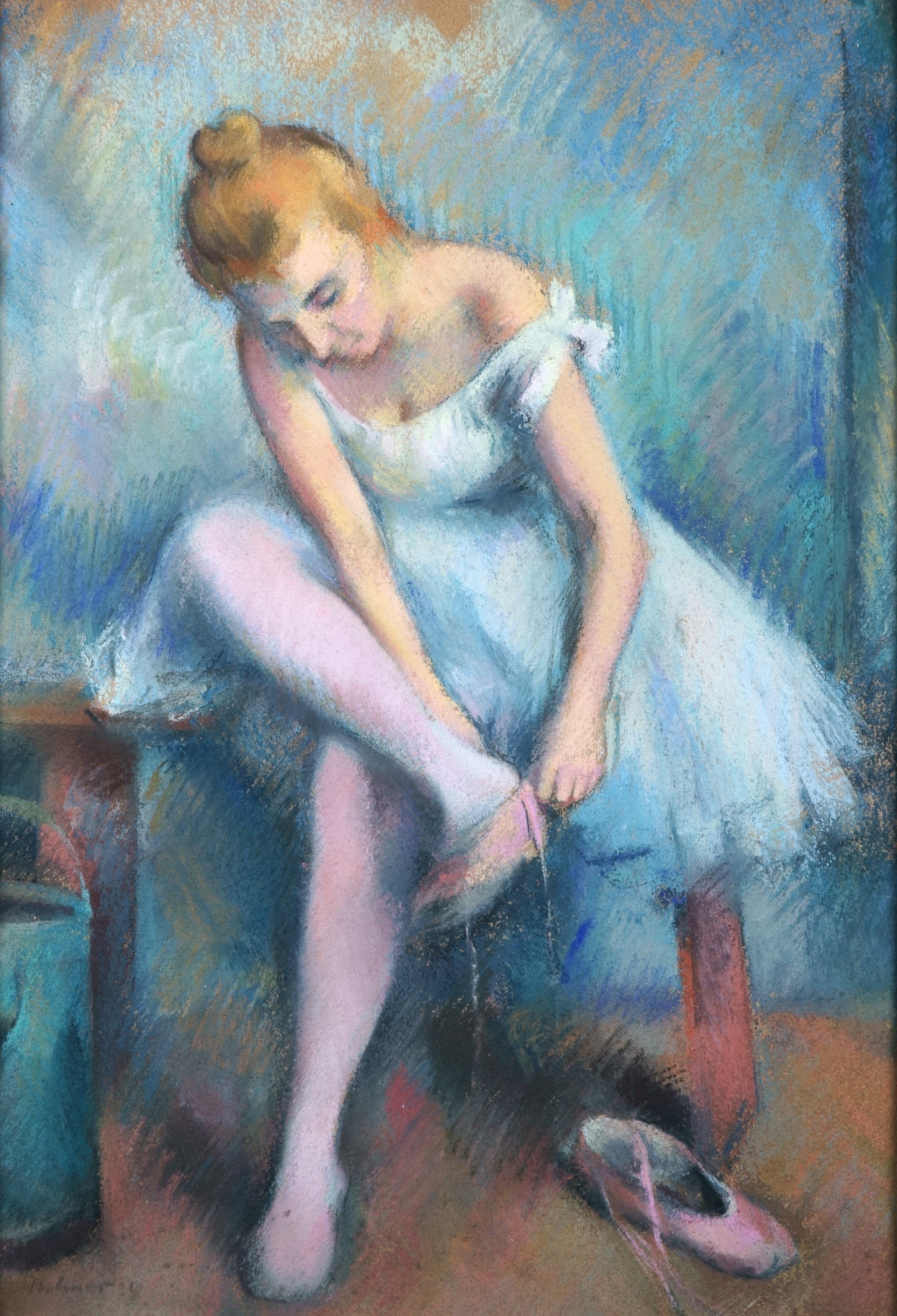Items Similar to "Interior Scene with Figures in Living Room" Post-Impressionist Oil Painting
Want more images or videos?
Request additional images or videos from the seller
1 of 22
Jacques Zucker"Interior Scene with Figures in Living Room" Post-Impressionist Oil Painting20th Century
20th Century
About the Item
A whimsical interior scene depicting two figures in the living room with an older person and young boy, perhaps Father and son with a door open into the background which shows Parisian streets with a flag of France. The bright colors and quick brush strokes are what makes this painting so attractive and desirable. The artist captured the times of his generation in an emotional and impactful way, a sweetness is felt throughout as we can imagine the sentiment in the thick textured oil pastel. The piece is done in a highly impressionistic manner with unique colors and expressions. The piece is done in a highly impressionistic manner and is a wonderful display of Zucker's more impressionistic styles, with bold colors of joyful turquoise, pink, and softer colors of light blue, hints of yellow, and pops of white. This painting is signed lower right and comes housed in an antique wood frame with washed wine-tone linen liner under glass with hanging wire on verso ready to be displayed.
Art measures 13 x 17 inches
Frame measures 27.5 x 31.5 inches
Jacques Zucker was born in 1900 in Radom, Poland. He was a notably famous Jewish American artist mostly known for his expressionist figure paintings. In his young years he traveled to Palestine to study fine arts at the Bezalel Art School in Jerusalem. In 1917 he joined the British Royal Fuesiliers under the leadership of General Allenby to liberate Palestine from the Turks. After the first World War he settled in Paris, where he continued his studies at Académie Julian and Academie Colarossi. He then emigrated to the United States in 1922 and continued his art studies at the National Academy of Design. He supported himself by designing jewelry.
In 1925 he returned to Paris and studied at the Academie de la Grande Chaumier et Colarossi. During the Depression he worked for the WPA. From 1928 he took part in the Paris Salons: Autumn and the Tuileries. His works are expressionistic variations in the type of the Ecole de Paris. As a protégé of both Chaim Soutine and Renoir, hints of their style can be observed in much of his own work. Zucker’s style, that may have been influenced from the art of artists such as Marc Chagall, took pride in being an “internationalist”, standing the art of painting in its highest expression is universal no matter where the canvas was created.
People who respond to quality in art will understand the beauty and meaning, in their own land or in a foreign land, this was his main idea behind his artworks that was exhibited in numerous solo show in leading galleries and museums in New York, Paris, Tel Aviv, and other art centers. Claude Roger-Marx of Figaro Litteraire, dean of French art critics, write a comprehensive study of Zucker’s illustrated with 135 color and black and white plates. He traveled widely, including Italy, Spain, Portugal, Mexico and Israel. From then on Zucker lived alternately in New York and Paris, maintaining homes in both places, and spent considerable time painting in Mexico, Portugal, Greece, and Israel.
Zucker's post-impressionist works including town and landscapes, still-lives, and portraits, are part of an array of permanent installments in numerous museums and private collections in Tel Aviv, including the Joseph Hirschorn collection in Washington, D. C., the Museum of Modern Art in Paris, and the Bezalel Art Museum in Jerusalem. In 1947 he settled in Arcueil near Paris. Zucker died in 1981 in New York.
PROVENANCE: Jacques Zucker Estate; Private Collection New York City; Lilac Gallery Collection. The piece will be stamped from Lilac Gallery on its verso.
- Creator:Jacques Zucker (1900 - 1981, American)
- Creation Year:20th Century
- Dimensions:Height: 27.5 in (69.85 cm)Width: 31.5 in (80.01 cm)Depth: 2 in (5.08 cm)
- Medium:
- Movement & Style:
- Period:
- Condition:The painting is in very good condition for the time period besides some pinholes in the center area, and the frame also shows some ordinary wear from age with a backing of a 1960 exhibition poster of Galerie Paul Pétrides 'Peintures Jacques Zucker'.
- Gallery Location:New York, NY
- Reference Number:
About the Seller
5.0
Platinum Seller
These expertly vetted sellers are 1stDibs' most experienced sellers and are rated highest by our customers.
Established in 2012
1stDibs seller since 2015
1,484 sales on 1stDibs
Typical response time: 1 hour
- ShippingRetrieving quote...Ships From: New York, NY
- Return PolicyA return for this item may be initiated within 7 days of delivery.
More From This SellerView All
- "Interior View into the Patio" Colorful Post-Impressionist Scene Painting FramedBy Jacques ZuckerLocated in New York, NYThis painting depicts an interior scene done in Paris. The fun details are what make this painting so attractive and desirable; the living room opens out into the terrace, as we are ...Category
20th Century Post-Impressionist Interior Paintings
MaterialsArchival Paper, Gouache
- "Figures Seated around a Table with Flowers" Post-Impressionist Oil PaintingBy Jacques ZuckerLocated in New York, NYAn outstanding oil painting depicitng 3 figures seated around a table with flower vase. The bright colors and quick brush strokes are what makes this piece so attractive and desirabl...Category
20th Century Post-Impressionist Figurative Paintings
MaterialsCanvas, Oil
- "Young Boy with Toy Airplane" Post-Impressionist French Oil Painting on CanvasBy Jacques ZuckerLocated in New York, NYThis painting depicts a whimsical portrait of a young boy with light brown hair against a viridian green background. The piece is done in a highly impressionistic manner and is a won...Category
20th Century Post-Impressionist Figurative Paintings
MaterialsOil, Wood Panel, Canvas
- "Interior Scene with Figure and Flowers" Post-Impressionist Oil Painting FramedBy Jacques ZuckerLocated in New York, NYAn intimate interior scene of a woman reclining in her living room with a bouquet of flowers on a sunny afternoon. We are charmed by the rich choice of color and intimate details thr...Category
20th Century Post-Impressionist Interior Paintings
MaterialsPanel, Oil
- "Interior Scene of Woman in Paris" Post-Impressionism Oil Painting on CanvasBy Jacques ZuckerLocated in New York, NYThis painting depicts an interior scene of a woman seated at an apartment in Paris with a window that overlooks the city and an iconic church with the artist's reflection in the armo...Category
20th Century Post-Impressionist Interior Paintings
MaterialsOil, Canvas
- "Laundry" Post-Impressionism French Oil Painting Interior Scene Figure on BoardBy Jacques ZuckerLocated in New York, NYThis painting depicts a whimsical portrait of a young lady washing her laundry in front of a house. This piece was most likely executed in the 1930's, as the colors are darker than Z...Category
1960s Post-Impressionist Figurative Paintings
MaterialsOil, Board
You May Also Like
- "Traces" -Contemporary Paint - Large size Made in Italy by Marilina MarchicaBy Marilina MarchicaLocated in Agrigento, AGFragments Family House oil and wall Paper on canvas 120x120 cm Original Art abstract Minimalism this Artworks is part of a series "Fragments Family House" tell and trace the evolut...Category
2010s Contemporary Interior Paintings
MaterialsOil Pastel, Archival Paper, Oil, Canvas
- Back at the Beach HouseBy Wencke UhlLocated in Bonn, NWOriginal painting. Acrylic, paper and oil pastels on high quality linen canvas stretcher. Finished off with a soft glossy varnish. 70 x 90 cm 27.5 x 35.4". The sides are painted and...Category
2010s Contemporary Figurative Paintings
MaterialsOil Pastel, Archival Paper, Acrylic
- Spanish dancers pastel drawingLocated in Barcelona, BarcelonaPierre Carro (1952) - Spanish Dancers - Pastel Drawing measurements 45x34 cm. Frame measurements 93x79 cm.Category
1980s Post-Impressionist Figurative Paintings
MaterialsPastel
- Ballerina in the dressing roomLocated in Berlin, DEKarl Stohner (1894 Mannheim - 1957 Paris), Ballerina in the dressing room, 1924. Pastel on painting cardboard, 65 x 45 cm, 77,5 x 59,5 (frame), signed lower left "Stohner" and dated "[19]24". Behind glass in gold stucco frame of the time. - Painting cardboard slightly warped, in the lower area minimally stained, frame with age patina and traces of abrasion. - The Naturalness of Artificiality - We see a ballerina putting on her right ballet shoe while the left one is still lying on the floor in front of her. It is precisely the casualness of the scene that gives it its intimacy: the blonde young woman is completely absorbed in the activity of getting ready for the dance, oblivious to us, while we are positioned right in front of her in the dressing room, inaccessible to the audience, watching her dress. Even though she does not yet perform a dance step, there is a graceful elegance in the action shown that seems quite natural in contrast to the rehearsed art form of dance. The young woman is not presenting herself to an audience in a perfectly formed movement, but is performing an everyday action, unaware that she is being watched. Concentrated, almost devotional, she pulls the ballet slipper over the verses, not noticing that one of the straps of the tutu has slipped off her shoulder, reinforcing the erotic moment of the scene. Inspired by Edgar Degas, Karl Stohner has painted the scene in strong pastel tones. The dominant blues and turquoises give the scene a magical, mysterious quality and, like the pink of the stockings and ballet slippers, are borrowed from Degas's dancers. Degas's colors, however, are cooler tempered, which is particularly evident in the light impasto applied incarnate. This is where the vividness of Auguste Renoir comes into play, making the dancer seem entirely flesh and blood. Karl Stohner, who has studied the pastels of Degas and Renoir intensively, combines the two artists here to create his own pictorial language. He has laid out the background in broad layers of strokes, ranging in color from white to turquoise to dark blue. The result is a dynamic, pattern-like structure that contrasts with the woman's calm, inward-looking posture. The fund anticipates the dynamics of the choreography of the dance for which the ballerina is preparing. At the same time, the broad pastel line in the background is an adequate means of painting to depict the soft, flowing elegance of the dancer. About the artist Against the wishes of his wealthy parents, Karl Stohner decided to become a painter. His talent was discovered by the director of the Mannheim Art Gallery, Fritz Wichert, who supported him from then on, including financing study trips to Paris. There he discovered the art of Degas, Cézanne and Renoir, which inspired his work. GERMAN VERSION Karl Stohner (1894 Mannheim - 1957 Paris), Ballerina im Ankleideraum, 1924. Pastell auf Malkarton, 65 x 45 cm, 77,5 x 59,5 (Rahmen), unten links mit „Stohner“ signiert und auf „[19]24“ datiert. Hinter Glas im Goldstuckrahmen der Zeit. - Malkarton leicht verzogen, im unteren Bereich minimal fleckig, Rahmen mit Alterspatina und Abriebspuren - Die Natürlichkeit der Kunstform - Wir sehen eine Ballerina, die sich den rechten Ballettschuh anzieht, während der linke noch vor ihr auf dem Boden liegt. Gerade aus der Beiläufigkeit der Szenerie speist sich ihre Intimität: Die blonde...Category
1920s Post-Impressionist Figurative Paintings
MaterialsPastel
- Dimanche - Post Impressionist Figurative Interior Oil Painting Paul Elie GernezBy Paul-Élie GernezLocated in Marlow, BuckinghamshirePost impressionist signed and dated oil on paper laid on panel by French painter Paul Elie Gernez. The work depicts a woman wearing a black dress with...Category
1920s Post-Impressionist Figurative Paintings
MaterialsLaid Paper, Paper, Oil, Panel
- California Post-Impressionist 'Woman Seated', Louvre, LACMA, Académie ChaumièreBy Victor Di GesuLocated in Santa Cruz, CADi Gesu estate stamp verso and painted circa 1955. Winner of the Prix Othon Friesz, Victor di Gesu first attended the Los Angeles Art Center and the Chouinard Art School before movi...Category
1950s Post-Impressionist Interior Paintings
MaterialsGouache, Laid Paper



